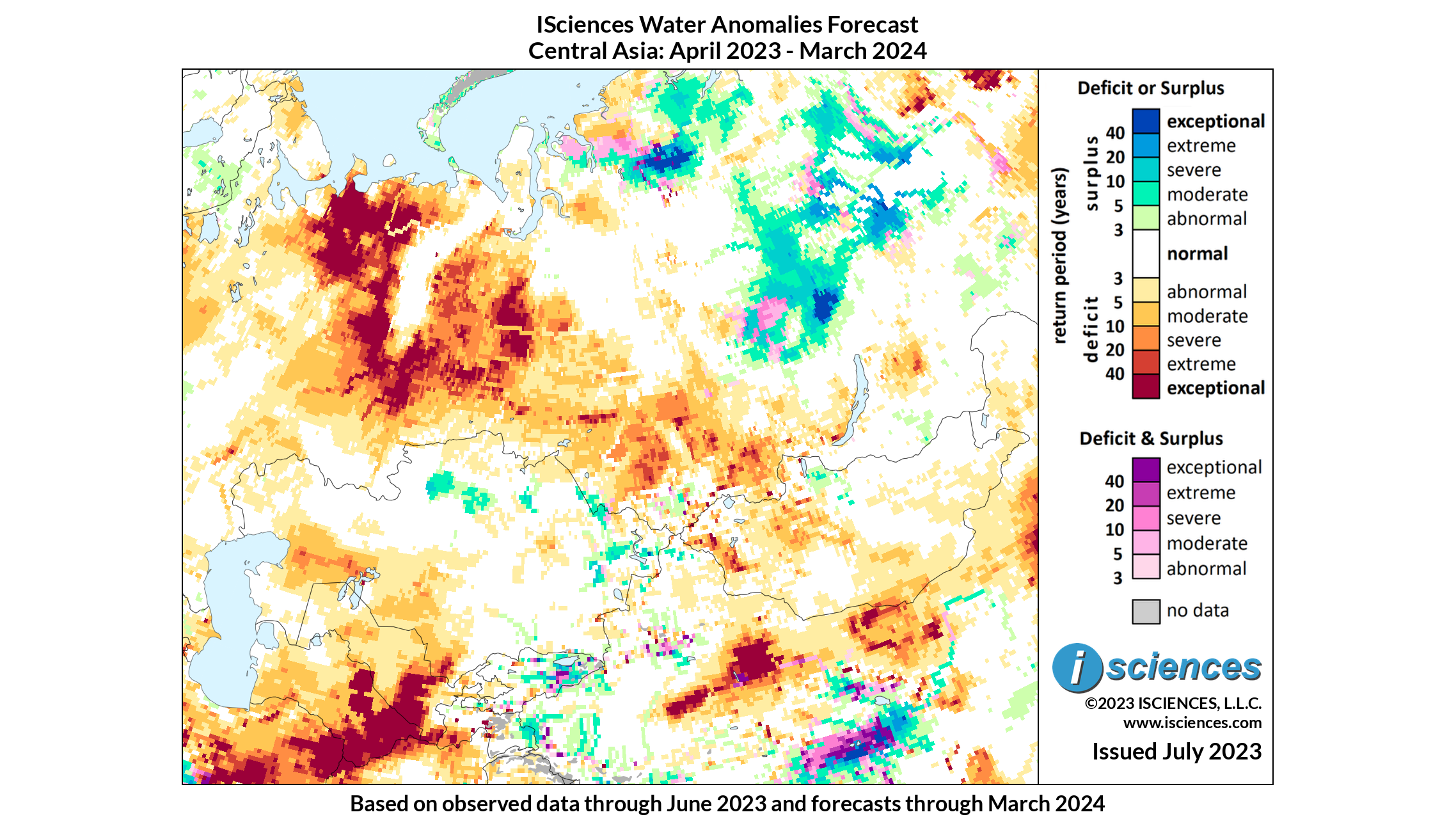Central Asia & Russia: Deficits continue in W Russia, Central Asia
2 August 2023
THE BIG PICTURE
The forecast ending in March 2024 anticipates widespread deficits of varying intensity in western and southwestern Russia, with northern and central regions of Russia experiencing small, isolated areas of notable surplus. Intense deficits are expected in most eastern Central Asian regions.
Exceptional deficits are forecast in the following areas:
Northwestern Russia, throughout the Nenets Autonomous Okrug, Khanty-Mansi Autonomous Okrug, and the Komi Republic, continuing south into southern regions of the Sverdlovsk Oblast.
Southern Russia, appearing in pockets across Irkutsk Oblast and the Tuva Republic.
Easternmost regions of Turkmenistan and Uzbekistan.
A mixture of extreme to exceptional surplus and mild transitional conditions are expected in:
Northern Russia, in western areas of the Taymyrsky Dolgano-Nenetsky District in the Krasnoyarsk Krai region.
Central Russia, in areas throughout the Katangsky District, and into southern portions of the Sakha Republic.
Eastern Kyrgyzstan, in areas south of the Issyk Kul Lake.
The 3-month maps (below) show the evolving conditions in more detail.
FORECAST BREAKDOWN
The forecast through September 2023 anticipates exceptional deficits in western Russia, particularly near Nenets Autonomous Okrug and Khanty-Mansi Autonomous Okrug, are expected to persist, but slightly decrease in magnitude. Similar anomalies in Southern Russia across Irkutsk Oblast and the Tuva Republic are expected to remain, but similarly diminish in size. Sparse but concentrated areas of surplus are also expected to remain in central Russia, throughout the Katangsky District, and into southern portions of the Sakha Republic. Further south, intense deficits in Turkmenistan and Uzbekistan are expected to disappear.
From October through December 2023, most notable deficits across Russia will decrease in severity, with most anomalies becoming mild. However, intense deficits are expected to remain in central areas of the Tyumen Oblast, as is intense surplus occurring in Central Russia, and across Kyrgyzstan and Tajikistan.
The forecast for the final months – January 2024 through March 2024 – indicates that anomalies across Russia and Central Asia will continue, with isolated deficits in western Russia near the Tyumen Oblast, and intense surplus occurring across Central Russia, Kyrgyzstan, and Tajikistan.
Please note that WSIM forecast skill declines with longer lead times.
IMPACTS
In the Russian region of Sverdlovsk, drought and heat waves have caused notable damage to the development of crops in the area. Sergey Sharapov, First Deputy Minister of the Agro-industrial Complex and Consumer Market, reports that these conditions contributed to the death of 0.8% of local crops this year. Sharapov cited a lack of effective precipitation and hot, dry winds led to the deterioration of sufficient farming conditions for crops, and ultimately a significant decrease in the crop yields of grain. As of July 19, the death of crops across 6.475 thousand hectares was confirmed. Sharapov reported in detail that 887 hectares of grain and leguminous crops, over 1.1 thousand hectares of oilseeds, and 4.42 thousand hectares of fodder crops were destroyed.
Russian forests and the ecosystems within them are at major risk due to extreme dry conditions. Diana Meyere, a representative of the Museum of Nature and the head of the Society of Mycologists, expressed concern over the lack of growth exhibited by mushrooms typically grown within the forests, which wasn’t observed until mid-July. “I didn’t see a single chanterelle until mid-July,” said Meyere, “[...] now the forest is still completely empty,” she said. When asked whether the current season could be more fruitful than the last, Meyere said that it is unlikely.
On July 27th, Kazakhstan’s government held a meeting to discuss the severity of the country’s current drought, as well as potential avenues for state-assisted support for farmers. Due to prolonged dry conditions in the country, relevant officials and corporations are considering a deferment on loans to farmers affected by the drought. Deputy head of the ministry Yerbol Taszhurekov stated that “The regions allocated 11.7 billion tenge to subsidize the cost of feed costs in 2023. In addition, the food corporation has formed a forage fund of grain in the amount of 235.2 thousand tons. If necessary, this grain will be sent as support to livestock and poultry farms at a reduced price. For the first time since this year, additional volumes of diesel fuel will be allocated at a reduced price for fodder harvesting,” he added.
NOTE ON ADMINISTRATIVE BOUNDARIES
There are numerous regions around the world where country borders are contested. ISciences depicts country boundaries on these maps solely to provide some geographic context. The boundaries are nominal, not legal, descriptions of each entity. The use of these boundaries does not imply any judgement on the legal status of any territory, or any endorsement or acceptance of disputed boundaries on the part of ISciences or our data providers.
Subscribe to our monthly Water Watch List
Search blog categories
- *Precip/Temp Outlooks 101
- *Press Releases 1
- *Special Topics 16
- *Water Watch Lists 108
- Africa 117
- Australia & New Zealand 102
- Canada 103
- Central Asia & Russia 101
- East Asia 101
- Europe 108
- Mexico & C. Amer. & Carib 106
- Middle East 110
- South America 115
- South Asia 106
- Southeast Asia & Pacific 110
- United States 107
Search blog tags



